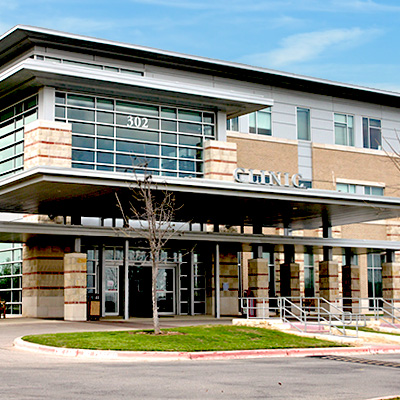What is pelvic floor therapy?
Pelvic floor therapy is a form of physical therapy designed to improve function in your pelvic floor muscles—those that support your bladder, bowels and uterus. Pelvic floor therapy can retrain your body to help correct pelvic floor dysfunction, where pelvic floor muscles may be tight, uncoordinated or weak.
While pelvic floor disorders such as bladder or bowel leakage, going to the bathroom urgently and often, or pelvic pain can be frustrating, pelvic floor physical therapy can help to greatly improve your quality of life. You’ll learn exercises and techniques to coordinate, relax and strengthen your pelvic floor muscles as needed so they can support your pelvic organs effectively.
Our approach to pelvic floor physical therapy
At Baylor Scott & White, our pelvic floor physical therapists offer programs tailored to address issues causing incontinence, pelvic organ prolapse, pain or sexual dysfunction, or those that are otherwise keeping you from living your fullest life. You’ll receive:
- An individualized care plan based on the latest research
- Personalized, one-on-one therapy with a compassionate therapist
- Team-centered care that includes your physical therapist and your medical providers
- Therapies and treatments to improve coordination and sensory awareness so you can better understand and control pelvic function
-
Personalized education
Your pelvic floor therapist will first evaluate you and create a treatment plan to address your condition, then help you understand the causes of any deficits or dysfunction so you can address them effectively.
During therapy, we work with you to find what treatments work best for you. For example, understanding how to do a Kegel correctly, if appropriate, as many people have never been taught how to do this. We also recommend behavior and lifestyle modifications, postural changes and personalized exercises, teaching you to do them at home properly so you can continue to improve over time.
-
State-of-the-art technology and techniques
It can be hard to feel or visualize how the pelvic floor works or whether you’re completing an exercise correctly. Your therapist may use technologies such as biofeedback and electrical stimulation, as well as specific cueing tailored for you, that helps you understand how your muscles function so you can get the maximum benefit from your pelvic floor physical therapy.
-
Integrated, comprehensive care
Our pelvic floor physical therapists work with OBGYNs, urogynecologists, and other providers to provide comprehensive care for pelvic floor dysfunction related to pregnancy and childbirth, cancer or cancer treatment, neurological issues such as stroke or Multiple Sclerosis, and other conditions. You’ll also have access to dietary guidance and supportive devices as needed, and your therapist coordinates your care with your medical providers if they feel surgery or additional treatments are necessary.
Pelvic floor symptoms and conditions we treat
Pelvic floor dysfunction may be associated with numerous conditions across your life, from childbirth to trauma. Additionally, it can cause painful symptoms that disrupt your quality of life. A few conditions and symptoms we treat include:
- Pregnancy and postpartum: During pregnancy, pelvic floor therapy may help alleviate discomfort, reduce worsening bladder and bowel symptoms, and prepare you for labor and delivery as well as postpartum recovery. Check with your OBGYN if this is a safe option for you. During the postpartum period, it is generally advised to return to pelvic floor physical therapy after seeing your OBGYN for your six-week follow-up. But you can always ask your provider for a referral to return sooner if needed. Continuing with your physical therapist while postpartum can improve your recovery and get you back to your normal activities sooner and with less discomfort.
- Bladder and bowel control: Our pelvic floor physical therapists can teach you exercises and behavior modifications to better control urinary and bowel functions.
- Pelvic pain: Depending on what’s causing your pain, you may benefit from biofeedback, manual therapy, exercises such as postural training, stretching and strengthening, or changes to daily activities.
- Pelvic organ prolapse: We can help you with lifestyle changes and prescribe exercises and devices to alleviate symptoms of pelvic organ prolapse.
- Painful sex: Some conditions that cause painful intercourse can be treated through pelvic floor physical therapy.
Pelvic floor therapy techniques and treatments offered
At Baylor Scott & White, you can benefit from numerous techniques and treatments to help you control, relax and strengthen your pelvic floor muscles.
Biomechanical guidance
We provide teaching and exercise for biomechanical, or postural, changes you can make to improve pelvic floor balance and function.
Dry needling
A therapist inserts thin needles into muscle trigger points in surrounding areas to alleviate discomfort and tension contributing to pelvic floor dysfunction.
Education
We provide guidance for behavioral, dietary or lifestyle changes that can benefit your pelvic floor health and improve your quality of life.
Electrical stimulation
A therapist applies a mild electrical current to strengthen a muscle or get it accustomed to nerve activity.
Electromyography biofeedback
Sensors help you understand your pelvic floor activity so you can better control muscles.
Exercises
You’ll learn exercises and techniques that engage specific muscle groups to address ongoing issues.
Myofascial release
A therapist uses manual (hands-on) therapy to target and release trigger points in your muscles as well as tension in your connective tissues, such as scar tissue created by inflammation or injury.
Soft tissue mobilization
Your therapist can use various massage techniques to release tension in your muscles contributing to pain and pelvic floor dysfunction.
What to expect from pelvic floor physical therapy
A primary care doctor, OBGYN or other provider may refer you to pelvic floor physical therapy. We’ll start with a conversation to understand your condition, how it affects your daily activities and any concerns you might have.
You will then have a private, one-on-one evaluation with a physical therapist, who will holistically assess the strength and muscle coordination of your hips, lower back and pelvic floor. Based on this evaluation, your medical history and diagnosis, your physical therapist will create a treatment plan that meets your needs. The plan may address a range of physical and behavioral aspects of your pelvic floor dysfunction.
You’ll receive guidance in the clinic and exercises to perform at home so you can relieve discomfort, improve function and go about your life with confidence.
Find a location for pelvic floor therapy near you
We help you get care at a location that fits your needs. We offer several locations for your care, including urogynecology centers in North and Central Texas.
Baylor Scott & White offers pelvic floor therapy in North and Central Texas, including locations within Baylor Scott & White Institute for Rehabilitation. Our team delivers individualized, one-on-one care whether you are seeking a diagnosis, dietary and lifestyle modification guidance or a personalized therapy and treatment plan.

Baylor Scott & White All Saints Medical Center - Fort Worth
1400 8th Ave , Fort Worth, TX, 76104
Baylor Scott & White Clinic - Cedar Park
910 E Whitestone Blvd , Cedar Park, TX, 78613- Monday: 8:00 am - 5:00 pm
- Tuesday: 8:00 am - 5:00 pm
- Wednesday: 8:00 am - 5:00 pm
- Thursday: 8:00 am - 5:00 pm
- Friday: 8:00 am - 5:00 pm
- Monday: 7:00 am - 5:00 pm
- Tuesday: 7:00 am - 5:00 pm
- Wednesday: 7:00 am - 5:00 pm
- Thursday: 7:00 am - 5:00 pm
- Friday: 7:00 am - 5:00 pm
- Saturday: 9:00 am - 2:00 pm

Baylor Scott & White Clinic - College Station Rock Prairie
800 Scott and White Dr , College Station, TX, 77845- Monday: 7:30 am - 5:00 pm
- Tuesday: 7:30 am - 5:00 pm
- Wednesday: 7:30 am - 5:00 pm
- Thursday: 7:30 am - 5:00 pm
- Friday: 7:30 am - 5:00 pm

Baylor Scott & White Clinic - Round Rock 300 University
300A University Blvd , Round Rock, TX, 78665- Monday: 8:00 am - 5:00 pm
- Tuesday: 8:00 am - 5:00 pm
- Wednesday: 8:00 am - 5:00 pm
- Thursday: 8:00 am - 5:00 pm
- Friday: 8:00 am - 5:00 pm

Baylor Scott & White Clinic - Round Rock 302 University
302 University Blvd , Round Rock, TX, 78665- Monday: 8:00 am - 5:00 pm
- Tuesday: 8:00 am - 5:00 pm
- Wednesday: 8:00 am - 5:00 pm
- Thursday: 8:00 am - 5:00 pm
- Friday: 8:00 am - 5:00 pm

Baylor Scott & White Family Medical Center - Terrell
200 N Virginia St , Terrell, TX, 75160- Monday: 8:00 am - 5:00 pm
- Tuesday: 8:00 am - 5:00 pm
- Wednesday: 8:00 am - 5:00 pm
- Thursday: 8:00 am - 5:00 pm
- Friday: 8:00 am - 5:00 pm

Baylor Scott & White Hillcrest Urology - Waco
50 Hillcrest Medical Blvd Office Building I, Suite 102, Waco, TX, 76712- Monday: 8:00 am - 5:00 pm
- Tuesday: 8:00 am - 5:00 pm
- Wednesday: 8:00 am - 5:00 pm
- Thursday: 8:00 am - 5:00 pm
- Friday: 8:00 am - 5:00 pm

Baylor Scott & White Institute for Rehabilitation - Angus Road
11623 Angus Rd Ste 18, Austin, TX, 78759
Baylor Scott & White Institute for Rehabilitation - Argyle
250 N US Highway 377 Ste 300, Argyle, TX, 76226
Baylor Scott & White Institute for Rehabilitation - Austin Onion Creek
11215 IH-35 Ste 102, Austin, TX, 78747
Baylor Scott & White Institute for Rehabilitation - Cedar Park East
701 East Whitestone Blvd Ste 100, Cedar Park, TX, 78613- Monday: 7:00 am - 7:00 pm
- Tuesday: 7:00 am - 7:00 pm
- Wednesday: 7:00 am - 7:00 pm
- Thursday: 7:00 am - 7:00 pm
- Friday: 7:00 am - 7:00 pm

Baylor Scott & White Institute for Rehabilitation - Garland Shiloh
333 N Shiloh Rd Ste 108, Garland, TX, 75042
Baylor Scott & White Institute for Rehabilitation - Georgetown
4112 Williams Dr Ste 103, Georgetown, TX, 78628
Baylor Scott & White Institute for Rehabilitation - Grapevine
1643 Lancaster Dr Ste 100, Grapevine, TX, 76051
Baylor Scott & White Institute for Rehabilitation - Irving MacArthur
2001 N MacArthur Blvd Bldg I, Ste 550, Irving, TX, 75061
Baylor Scott & White Institute for Rehabilitation - Manor
12400 Gregg Manor Rd Ste 101, Manor, TX, 78653
Baylor Scott & White Institute for Rehabilitation - McKinney Lake Forest
5236 W University Dr Ste 3500, McKinney, TX, 75071
Baylor Scott & White Institute for Rehabilitation - Mueller District
1801 E 51st St Ste 300, Austin, TX, 78723
Baylor Scott & White Institute for Rehabilitation - North Austin
2200 Park Bend Dr Bldg 1, Ste 202, Austin, TX, 78757
Baylor Scott & White Institute for Rehabilitation - Pflugerville
16051 Dessau Rd Ste A, Pflugerville, TX, 78660
Baylor Scott & White Institute for Rehabilitation - Plano Alliance
4825 Alliance Blvd Ste 200, Plano, TX, 75093
Baylor Scott & White Institute for Rehabilitation - Round Rock University
300A University Blvd , Round Rock, TX, 78665
Baylor Scott & White Institute for Rehabilitation - South Lamar
3901 S Lamar Blvd Ste 140, Austin, TX, 78704
Baylor Scott & White Institute for Rehabilitation - William Cannon Drive
2501 W William Cannon Dr Building 1, Ste 102, Austin, TX, 78745
Baylor Scott & White Medical Center - College Station
700 Scott and White Dr , College Station, TX, 77845
Baylor Scott & White Medical Center - Grapevine
1650 W College St , Grapevine, TX, 76051
Baylor Scott & White Medical Center - Irving
1901 N MacArthur Blvd , Irving, TX, 75061
Baylor Scott & White Medical Center - McKinney
5252 W University Dr Highway 380 at Lake Forest Drive, McKinney, TX, 75071
Baylor Scott & White Medical Center - Plano
4700 Alliance Blvd , Plano, TX, 75093
Baylor Scott & White Medical Center - Round Rock
300 University Blvd , Round Rock, TX, 78665
Baylor Scott & White Medical Center - Temple
2401 S 31st St , Temple, TX, 76508
Baylor Scott & White North Texas Colon and Rectal Associates - Dallas
3409 Worth St Ste 600, Dallas, TX, 75246- Monday: 8:30 am - 5:00 pm
- Tuesday: 8:30 am - 5:00 pm
- Wednesday: 8:30 am - 5:00 pm
- Thursday: 8:30 am - 5:00 pm
- Friday: 8:30 am - 5:00 pm

Baylor Scott & White North Texas Colon and Rectal Associates - North Garland
7217 Telecom Pkwy Ste 100, Garland, TX, 75044
Baylor Scott & White Texas Urogynecology Associates - Dallas
4501 Swiss Ave , Dallas, TX, 75204- Monday: 8:30 am - 5:00 pm
- Tuesday: 8:30 am - 5:00 pm
- Wednesday: 8:30 am - 5:00 pm
- Thursday: 8:30 am - 5:00 pm
- Friday: 8:30 am - 5:00 pm

Baylor Scott & White Texas Urogynecology Associates - Grapevine
1631 Lancaster Dr Ste 370, Grapevine, TX, 76051
Baylor Scott & White Texas Urogynecology Associates - Irving
2001 N MacArthur Blvd Ste 425, Irving, TX, 75061- Monday: 8:30 am - 5:00 pm
- Tuesday: 8:30 am - 5:00 pm
- Wednesday: 8:30 am - 5:00 pm
- Thursday: 8:30 am - 5:00 pm
- Friday: 8:30 am - 5:00 pm

Baylor Scott & White Texas Urogynecology Associates - McKinney
5236 W University Dr Ste 2700, McKinney, TX, 75071
Baylor Scott & White Texas Urogynecology Associates - Plano
4601 Old Shepard Pl Bldg 3, Ste 305, Plano, TX, 75093- Monday: 8:30 am - 5:00 pm
- Tuesday: 8:30 am - 5:00 pm
- Wednesday: 8:30 am - 5:00 pm
- Thursday: 8:30 am - 5:00 pm
- Friday: 8:30 am - 5:00 pm

Baylor Scott & White Texas Urogynecology Associates - Terrell
200 N Virginia St , Terrell, TX, 75160